Time Travel Research Center © 2005 Cetin BAL - GSM:+90 05366063183 - Turkey/Denizli
Keith Fuhrhop 4 - 29 - 98
Some graphics borrowed from the references.
PHY 312
Breaking the Speed Barrier:
Alternatives to Faster than Light
Travel
"It is difficult to say what is impossible, for the dream of yesterday is the hope of today and the reality of tomorrow."
Robert H. Goddard
Introduction:
It is safe to say that no matter what form of propulsion humans may invent, it will still take many years to get to the nearest star, and hundreds to thousands of years to reach most other stars within our own galaxy. This basically restricts the human race from ever exploring any part of space outside our own solar system. What good is all the propulsion technology man will ever develop, if there will still be no way to traverse the stars without taking generations for each trip. Even the laws of relativity don't help this matter any. While these laws may be on the side of the traveler, they are definitely not on the side of the society. For example, suppose a traveler was moving at 99/100 times the speed of light toward another star. According to the time dilation law of relativity, if he traveled this way for ten years, then he would experience 10 years of time, while the people back at home would age just over 500 years!
There are, in theory, ways around this dilemma. Methods such
as travelling through a wormhole, and using warp technology are possible means
for solving this problem. These methods would get you to your destination in
hours to days depending on the circumstance, even if the destination were
thousands of light years away. There would also be no effects of relativity
because the voyager wouldn't be going fast enough for those laws to have a
significant impact. There may be light at the end of this travelling
tunnel.
Wormholes:
A wormhole is a hypothetical shortcut for travel between
distant points in the Universe. The wormhole has two entrances called "mouths".
A tunnel through hyperspace connects these mouths to each other. Hyperspace is
the hypothetical 'space' outside our universe.
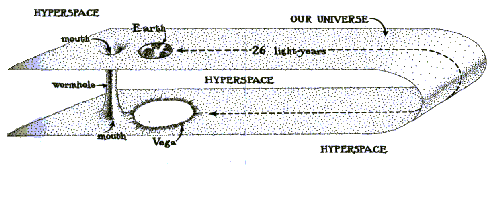
For example, in the diagram above the U-shaped plane is representative of our universe. We don't know what our three-dimensional universe looks like in a higher dimension. This diagram is drawn with our 3-d universe as a 2-d plane, so we can picture something that is a higher dimension. This is just an example of one of the infinite shapes that it could look like when it is represented as a plane. On this plane, the planet Earth and the star Vega are 26 light years apart. The wormhole extends from Earth, through hyperspace to Vega, and is only one kilometer long. If we enter the mouth near-Earth we just have to travel one kilometer down this tunnel to get to the other mouth and emerge near Vega, which is 26 light years away as measured by the external Universe. The wormhole's mouth would appear to be spherical to outside observers. If we looked into this wormhole from the Earth side we would be able to see Vega. This wormhole would act like an optical fiber through hyperspace.
Wormholes could be formed, according to Martin Kruskal of
Princeton University, through singularities (a point of infinite density, like
in a black hole). These singularities would somehow reach out throughout
hyperspace and find each other, and annihilate each other. This annihilation
would create the wormhole. The wormhole would grow in circumference to a certain
size, and then begins to shrink. It would eventually pinch off and creates two
singularities again. The only problem with this phenomenon is that this pinching
off process is so short that nothing whatsoever could travel through it. If
material does go into this pathway, it makes the lifetime of the wormhole even
shorter than before. This is because the material gets accelerated to ultra high
energy by the wormhole's gravity. This energized material bombards the throat of
the hole, and makes it constrict even faster.
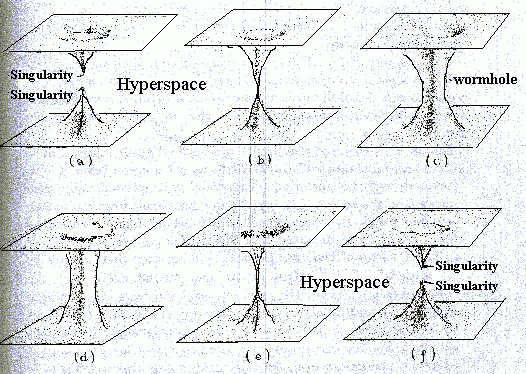
Using Einstein's field equations, three things can be discovered about the nature of wormholes. First, the only way to hold the wormhole open could be to thread it with some sort of material that pushes the walls apart gravitationally. This material is called exotic material. Second, this outward gravity could also act as a defocusing lens to any light that would go through the wormhole. It would pry the beam's light rays apart from each other. Finally, this material must have a negative average energy density as seen by a light beam travelling through it.
This does not mean that the exotic material has a negative
energy as measured by someone at rest inside the wormhole. Energy density is a
relative concept; in one reference frame it can be positive, while in another it
can be negative. The exotic material can have a negative energy density as
measured in the reference frame of a light beam that travels through it, but a
positive energy density as measured in the wormholes reference frame. Since
almost all forms of matter that humans have ever encountered have positive
average energy densities in everyone's reference frame, physicists have long
suspected that exotic material can't exist.
Time Travel:
If a wormhole can really be held open, then it will permit
one to travel over distances far faster than light. This means that if wormholes
are possible, then so is traveling backward in time. You might have already
learned about such time travel as a child if you can recall a famous
limerick:
There once was a lady named bright.
Who traveled much faster than light.
She departed one day in a relative way
and came home the previous night.
When analyzing this issue one can show that time hooks up
through the wormhole in the same manner as it hooks up outside the wormhole. A
good example of showing this fact would be if you suppose two hypothetical
wormholes. One of them would be in your home, and the other one would be
travelling away from Earth at nearly the speed of light. Also suppose that,
despite the relative motion of the wormhole mouths its distance through it still
remains 30 centimeters long. This is shown in the following
diagram.

There are two frames of reference at work here. As seen by
the external Universe, the two mouths move in different reference frames.
Therefore the mouths must experience different flows of time. On the other hand,
the interior of the wormhole sees both mouths as being at rest with respect to
each other. This means that the mouths must experience the same flow of time.
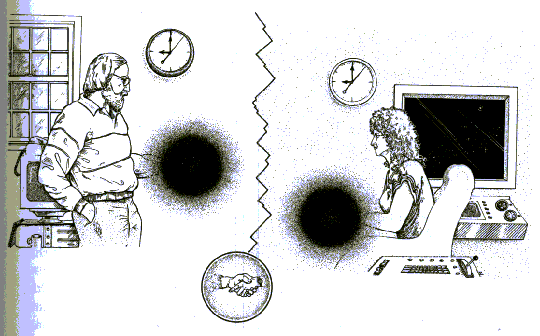
Now suppose that the one moving away from earth is inside someone's spaceship. The traveler and you both put your hands inside the wormhole and hold hands, and then the traveler takes off. The traveler goes at nearly the speed of light, and travels 6 hours out and 6 hours back, so the trip takes 12 hours as measured by the traveler. All the while the traveler and you were holding hands. Now that the traveler's trip is over, they send a message telling you to stop holding hands, so you let go. Because of relativity, this trip took 10 years to people on earth. So you wait the 10 years, and sure enough you see the travelers ship return, only he is still holding someone's hand through the wormhole. You stick your head through and discover that it is you only 10 years younger!
This example shows that you can't use the wormhole to travel
back in time any further than when it was created. If exotic material does
exist, then this fact is definitely true. This information would open up
countless problems, like the ones seen in movies such as Terminator,
Timecop, and Back to the Future. Where someone goes back in time,
and changes history because they know what the outcome is going to be. They then
go forward in time to reap the benefits of what they have done. This dilemma has
been named "The Matricide Paradox", after the well known question: What would
happen if you went back in time and killed your mother? Would you cease to
exist?
Warp Drives:
The first thing that comes to mind when thinking about this topic is that relativity states that nothing can move faster than the speed of light. However, when dealing with warped space-time this concept must be revised to saying that nothing can move locally faster than the speed of light. This means that nothing can travel faster than the speed of light with respect to local distance markers.
Clocks that are locally at rest will all keep the same time. However, general relativity allows space-time itself to expand. Objects on the other side of the Universe are flying apart at almost the speed of light, and yet they remain at rest relative to their local surroundings. If the Universe is large enough, then there also exists objects that are moving away from us faster than the speed of light, and yet are still at rest with respect to their local surroundings.
The curvature of space therefore produces a loophole in special relativity arguments. If space-time itself can be manipulated then objects can travel locally at very slow velocities, yet an accompanying expansion or contraction of space could allow huge distances to be traversed in short time intervals. This means that if space-time can be locally warped so that it expands behind the starship, and contracts in front of it, then the craft will be propelled along with the space that it is in (like a surfboard on a wave). The craft will never travel locally faster than the speed of light, because the light will be carried along the expanding wave of space too.
A good way to picture this is to imagine yourself in a starship with a star base close behind you, and far in front of you. If the space behind you expands you will find that the distance between you and the star base behind you has grown considerably. The opposite occurs in the front of your ship where the space contracts. This would make the base in front of you seem a lot closer, and reachable with normal rockets in a matter of minutes.
It is also possible to arrange the geometry in this solution so that the huge gravitational fields necessary to expand and contract space are never too large near the ship, or any star bases. In the vicinity of the ship and the bases space can be almost flat, and therefore the clocks on the ship and base can remain almost synchronized.
This all sound good in theory, however we need to know what
powers this device. This problem is almost greater for the warp drive than for
wormholes because of the distribution of matter and energy required to produce
the needed curvature of space-time. For the case of the wormhole, the exotic
material had to have a negative energy density as measured in the reference
frame of a light beam that travels through it. However, it could also have a
positive energy density as measured in the wormholes reference frame. For the
case of the warp drive, both the energy measured by the light and the energy
measured by the travelers on the starship would measure the exotic matter to
have negative energy.
Advanced Theories:
The warp drive would mean that one could travel to a star distance D away, and return home so that people on Earth would have aged less than (2D/c) years. (c is the velocity of light) In other words, the proper time of the traveler would be identical to that of someone on Earth.
Another factor of the warp drive is that the actual "warp bubble" that surrounds the ship must be exceedingly thin as compared to its radius. The forward edge of this bubble is where space contracts, and the back edge is where it expands.
This constrains the negative energy to an exceedingly narrow band surrounding the ship. Recently, a man named Alcubierre discovered the metric to warp travel, it is:
ds2 = -dt2 + [dx -
vs(t)f(rs(t))dt]2 + dy2 +
dz2 (1)
where xs(t) is the trajectory of the center of
the bubble and vx(t) = dx(t)s/dt is the bubble's velocity.
The variable rs(t) measures the distance outward from the center of
the bubble given by
rs(t) = [(x-xs(t))2 +
y2 + z2]0.5 (2)
The shape function of the bubble is given by
f(rs). This is an arbitrary function, which decreases from unity at r
= 0 (the location of the space ship) to zero at infinity. Alcubierre originally
chose to be function to be
tanh[s(rs - R)] - tanh[s(rs + R)]
f(rs) = ---------------------------------------- (3)
2 tanh[s R]
The variable R is the radius of the warp bubble, and s is a free parameter, which can be used to describe the thickness of the bubble walls.
As a warp bubble travels through space and passes someone
that falls within the warp bubble an interesting effect occurs. The stationary
observer begins to accelerate, relative to observers far outside the bubble, in
the direction of the traveler in the bubble. Once the observer is inside the
bubble they travel at a constant velocity (always less than the bubble unless
the observer passes through the center of it) until they near the outside of it
again. The observer then decelerates back to being stationary again in the exact
same way they initially accelerated. No residual momentum is imparted on these
observers during the "collision" however, they have been displaced forward in
space along the trajectory of the bubble. Also, observers at different distances
from the center of the bubble will experience different velocities and
accelerations with relation to each other.
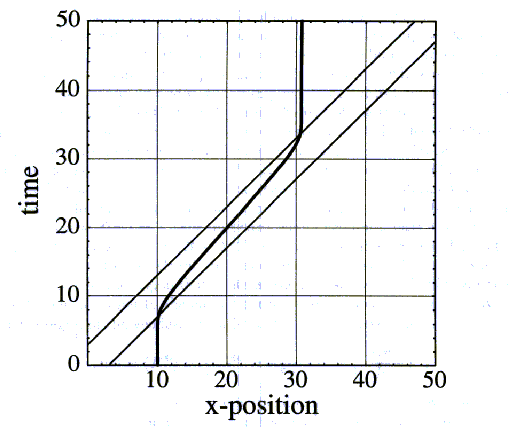
This position-time graph shows what is going on during this
process. The thick line is the stationary observer, and the two parallel lines
represent the front and back of the warp bubble. The bubble has a radius of 3,
and a velocity of 1, and the s parameter is also 1. The plot shows an observer
who begins at rest at x = 10, y2 + z2 = 4. The shape
follows the results of the function in equation (3).
The ship that produced this warp bubble would have to make sure that its center of mass was in the exact center of the bubble. This ship would then experience a net force pushing it opposite to the direction of motion of the bubble. This ship would therefore have to use its engines to maintain its position in the bubble. Also, the ship would be subject to internal stresses on any parts that extended sufficiently far away from the center.
Once again, this ship would be powered by negative energy.
In fact, the energy density measured by any geodesic observer is always
negative. The distribution of negative energy is concentrated in a toroidal
region perpendicular to the direction of travel.
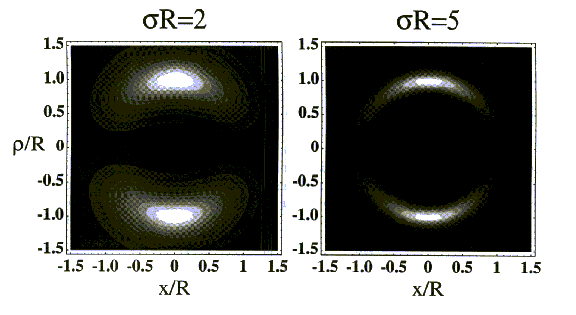
The negative energy density is plotted for a longitudinal cross
section of the warp metric at constant velocity vs = 1 to the right
of the Alcubierre shape function. The black regions are absent of matter, while
the white regions are maximal negative energy.
On the down side of this theory, the energy required for a
warp bubble is immense. For a bubble 100 meters across, the energy required to
sustain this would be on the order of E <= [-6.2x1065
(vb)] grams (vb is the speed of the warp bubble). Since
the mass of a galaxy (Mgalaxy)is approximately 2x1045
grams, the total energy would be about [-3x1020 Mgalaxy x
vb]. This would make a warp bubble nearly impossible for conventional
use, however does not rule out the possibility of very tiny warp travel. Since
we don't know very much at all about negative energy there still might be a way
around this problem.
Negative Energy: Exotic Matter
The very concept of negative energy violates many laws. These laws include the second law of Thermodynamics (It is impossible for any system to operate in such a way that the sole result would be an energy transfer by heat from a cooler to a hotter body.), the cosmic censorship law (that all singularities have event horizon's around them), the weak energy condition, traversable wormholes, warp drives, and the possibility of time machines.
In 1974 Hawking inferred that as a by-product of his discovery of black hole evaporation (Hawking radiation) that vacuum fluctuations near a black hole's horizon are exotic. When one tries to remove all of the magnetic and electric waves from a region of space, (create a perfect vacuum) there always remains a plethora of random electromagnetic oscillations. These oscillations are caused by a tug-of-war between the fields in adjacent regions of space. The fields "here" borrow energy from the fields "there", leaving the fields "there" with less energy. Or in other words, leaving negative energy in these placed for a moment before they steal energy from somewhere else, and the process continues. Under normal conditions on Earth, the average of these vacuum fluctuations is zero. This is not the case near the horizon of a black hole that is evaporating. There the average energy must be negative measured by the light beams, and is therefore exotic.
Vacuum fluctuations increase more and more as you try to
shorten electromagnetic waves. In a region of space 1.62 x 10-33
centimeters or smaller, the vacuum fluctuations are so huge that space, as
we know it, boils down and becomes a froth of quantum foam. (The size of an atom
is 10-13 centimeters) This is the same kind of foam that makes up the
core of a space-time singularity. At this small size space no longer seems
smooth. Instead space begins to writhe and bubble, becoming a froth of
probabilistic quantum foam.
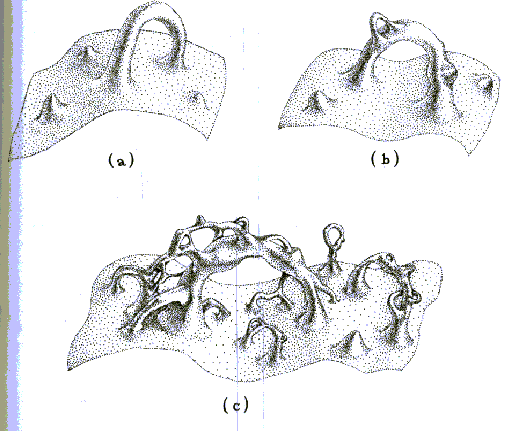
This picture shows what this "foam" might look like at any
time. A wormhole can originate from this foam. There are two different methods
for making a wormhole: a quantum method and a classical method. For the quantum
method, all that you would have to do is reach down into this foam and grab one
of these tubes and enlarge it to classical size (a size that humans could travel
through). The biggest problem with this is that we don't understand this foam
very well at all. In fact we aren't even 100% sure that it exists. In order to
accomplish this feat in classical standards one must tear two holes in space and
sew them together.
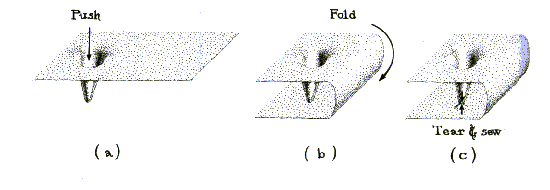
The problem with this method is that tearing a hole in
space-time produces a singularity; and the laws of quantum gravity govern
singularities. That would make this method a quantum mechanical and not a
classical one. It will be impossible to tell if this is possible until we
understand the laws of quantum gravity.
Conclusion:
At some level, the exotic solutions of general relativity required to keep wormholes open, allow time travel, and make warp drive possible all imply that on some scales matter must gravitationally repel other matter. If this material were proven to exist, we would still have a lot of work to do to apply this fact into some physical result. If man were ever able to develop machines to apply these facts then the entire universe would be at our fingertips. We would finally be able to explore what ever and where ever we wanted.
This would also have a profound impact on the way we would perceive things. If we do prove that exotic matter exists, and that it is easily attainable, then that means that if there is intelligent life in the universe they can do the same thing. There could be space-faring races all around our own galaxy, which we haven't even seen yet. These races could have even visited the Earth.
We must not get over excited with these theories. They have a long way to go before being proven. Even if they were, it would probably take countless generations to build a device, which would use these "exotic" concepts. However, it never hurts to dream.
Space would become the largest frontier that man has ever
faced. The means to conquer this frontier would be a feat so powerful that man
may even begin to work together to accomplish this goal. One thing is for
certain, the world would no longer be the same.
Bibliography
Ford, L. H., Thomas A. Roman. "Motion of Initial Observers
Through Negative Energy". Http://xxx.lanl.gov/form.gr-qc/9303038.
March 31, 1993.
Ford, L. H., Thomas A. Roman. "Restrictions On Negative
Energy Density In Flat Spacetime". http://xxx.lanl.gov/form.gr-qc/9607003.
January 24, 1997.
Ford, L. H., Michael J. Pfenning. "The Unphysical Nature of
"Warp Drive". Http://xxx.lanl.gov/form.gr-qc/9702026.
March 20, 1997.
Histock, William A. "Quantum Effects in the Alcubierre Warp
Drive Spacetime". Http://xxx.lanl.gov/form.gr-qc/9707024.
July 10, 1997.
Krauss, Lawrence M. The Physics of Star Trek. New
York: Harper Perrenial, 1995.
Mallove, Eugene. The Starflight Handbook. New York:
John Wiley & Sons, Inc., 1989.
Thorne, Kip S. Blackholes and Timewarps. New York: W. W. Norton & Company, 1994.
Hiçbir yazı/ resim izinsiz olarak kullanılamaz!! Telif hakları uyarınca bu bir suçtur..! Tüm hakları Çetin BAL' a aittir. Kaynak gösterilmek şartıyla siteden alıntı yapılabilir.
The Time Machine Project © 2005 Cetin BAL - GSM:+90 05366063183 -Turkiye/Denizli
Ana Sayfa /index /Roket bilimi /![]() E-Mail /CetinBAL/Quantum Teleportation-2
E-Mail /CetinBAL/Quantum Teleportation-2
Time Travel Technology /Ziyaretçi Defteri /UFO Technology/Duyuru